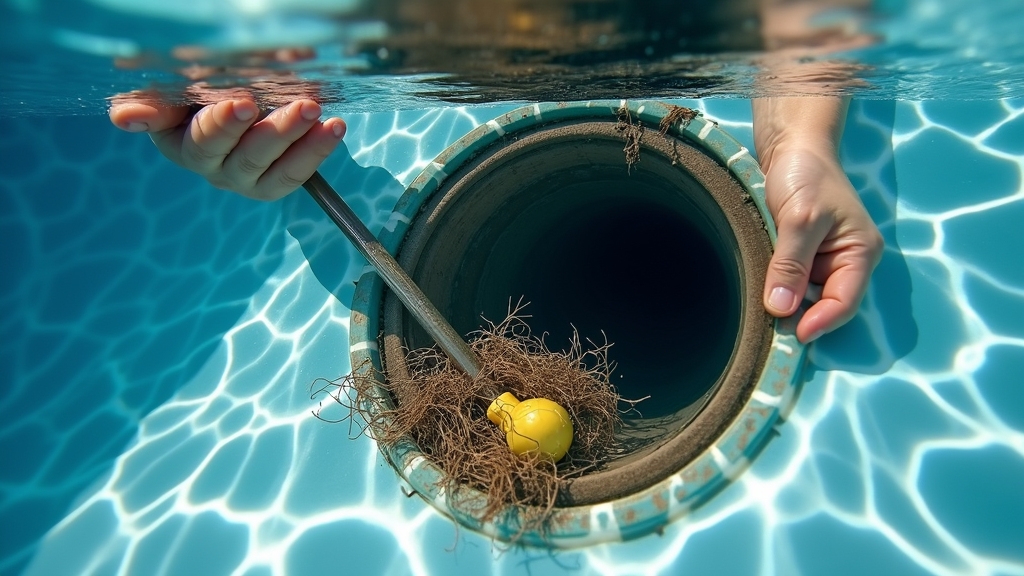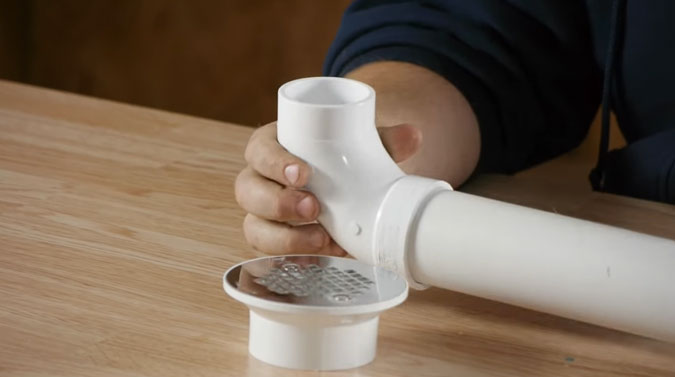To unclog your main pool drain, first turn off the pump and wear protective gear. Remove visible debris with a skimmer and brush gently to loosen buildup.
Then, use tools like augers to clear stubborn blockages carefully, avoiding pipe damage. You can also apply high-pressure water jets to flush deeper clogs, monitoring pressure to protect pipe integrity.
Once flow improves, restart the system to confirm clearance. Exploring these steps further reveals detailed methods for thorough maintenance and safety.
Key Takeaways
- Remove visible debris from the drain using a skimmer, net, and gentle brushing to prevent pushing clogs deeper.
- Turn off the pool pump’s power at the circuit breaker before attempting any manual or mechanical clearing.
- Use specialized tools like augers or Drain King to carefully break up and clear stubborn clogs inside the drain pipes.
- Employ high-pressure water jets combined with vacuum suction to flush out organic buildup and debris beyond manual reach.
- Inspect and replace damaged drain covers to prevent future clogs and ensure compliance with pool safety standards.
Causes of Main Pool Drain Clogs
Although you might regularly maintain your pool, various factors can still cause clogs in the main drain.
Common debris like leaves, twigs, grass clippings, and small objects such as toys or stones frequently accumulate at the drain opening, obstructing water flow. Proper removal often requires careful disassembly of impacted components to fully clear blockages.
Leaves, twigs, grass clippings, and small objects often clog the main drain, blocking water flow.
Organic buildup, including algae, biofilm, and sticky deposits from oils or lotions, further restricts pipes.
Dirt, sand, and silt often settle after storms or heavy use, especially when drain covers or strainer baskets are damaged or missing. Regular maintenance of the drain cover is essential to prevent such accumulations.
Structural issues like aging pipes with rough interiors or poorly installed drains increase debris retention.
Additionally, imbalanced pool chemistry accelerates biological growth and mineral scaling, narrowing pipe passages.
Environmental factors such as fallen leaves, windblown debris, and proximity to trees also elevate clog risks, demanding vigilant monitoring and cleaning.
Safety Precautions and Preparations
Preventing and addressing main pool drain clogs requires careful attention to safety protocols before any maintenance begins.
First, always wear chemical-resistant gloves, safety goggles, and appropriate footwear to protect against sharp debris, chemical exposure, and slips.
Use a mask if airborne particles or fumes are present.
De-energize the pool pump system by switching off the circuit breaker and applying lockout/tagout procedures to prevent accidental activation.
Confirm valve positions to isolate the drain line and ensure no electrical hazards exist near wet areas.
Inspect anti-entrapment drain covers for damage and compliance with safety standards; replace if necessary.
Prepare tools like augers or drain flushers and clear the work area to ensure safe maneuvering. It is important to avoid forcing tools through resistance to prevent getting stuck or damaging the line, especially near short-radius elbows.
Follow environmental guidelines for chemical use, ventilation, and waste disposal to maintain health and safety standards.
Manual Removal of Visible Debris
Effective manual removal of visible debris is a crucial first step in unclogging your main pool drain. Start by lowering the water level for safe access. This step helps prevent the introduction of pathogens from contaminated water.
Use a skimmer or net to collect large debris like leaves and grass clippings from the pool surface and around the drain. Gently brush the drain area to dislodge stuck debris without forcing it deeper.
Apply gentle water pressure with a garden hose to help wash away loosened particles. Continuously skim the surface to prevent new debris from settling near the drain. Removing the drain cover and plug can also help prevent pressure buildup underneath the pool shell during this process.
After removal, inspect the drain area to confirm it’s clear.
| Task | Recommended Tool |
|---|---|
| Large debris removal | Skimmer or net |
| Dislodge stuck debris | Pool brush |
| Surface debris washing | Garden hose (gentle flow) |
Mechanical Clearing With Tools
Once you’ve cleared visible debris manually, mechanical tools become necessary to address deeper or more stubborn clogs within the main pool drain.
First, disconnect the pool pump’s power at the circuit breaker to guarantee safety. Remove the strainer basket to access the drain line directly. The Drain King tool is particularly effective for unclogging pipes and can be used to restore flow by connecting it to a hose and PVC pipe. It is important to consider whether the pump is a submersible pump or an external pump, as this affects access and maintenance procedures.
Select the appropriate auger: hand augers for small, shallow clogs; machine augers for larger, deeper blockages. Insert the auger cable carefully, locking and disengaging the drum as you feed it through bends or changeovers.
Withdraw the cable while rotating to extract debris, repeating as needed. After clearing, reinstall the basket and restart the pump to verify flow.
Key considerations include: using gloves and eye protection, inspecting tool condition before use, knowing pipe layout to navigate bends, and avoiding excessive force to prevent pipe damage. Additionally, be mindful that the tool’s operation may expel debris back into the pool, so take precautions to minimize mess.
High-Pressure Water Methods
Although mechanical tools handle many pool drain clog issues, high-pressure water methods offer a powerful alternative for dislodging debris lodged beyond reach.
You’ll apply reverse water flow using calibrated pressure to push blockages away from the normal drainage direction, avoiding damage to plumbing or seals.
Shut down the pool pump, open access points, and connect a controlled water source, such as a garden hose with adjustable nozzle or pressurized pump, to introduce intermittent bursts.
Testing with high pressure water helps dislodge debris blocking the line. Understanding the differences between pressure-balancing valves and other water control components can help prevent unintended pressure fluctuations during this process.
Combining water jets with vacuum suction enhances debris removal, especially biofilm and algae buildup unreachable by hand tools.
Monitor pressure reduction to gauge progress, but avoid excessive force that risks harming elbows or liners. Post-clearing, flush the system under normal pump operation and inspect filters for residual debris to prevent recirculation.
High-pressure water methods effectively clear organic and loose debris but may require follow-up mechanical clearing for compacted blockages.
Frequently Asked Questions
How Often Should I Schedule Professional Pool Drain Inspections?
You should schedule professional pool drain inspections at least twice a year, especially if your pool sees heavy use or is older.
Seasonal changes also affect inspection frequency, so adjusting accordingly is vital.
Regular inspections help identify clogs, leaks, and worn parts early, ensuring your system operates efficiently and safely.
Staying compliant with local regulations and preventing costly repairs makes adhering to this schedule necessary for maintaining your pool’s best performance.
Can Chemical Cleaners Help Prevent Main Drain Clogs?
Chemical cleaners can’t consistently clear clogs or curb accumulation in your main pool drain.
They chemically combat certain organic compounds but fail against debris like leaves or algae typical in pool drains.
Using harsh chemicals risks corroding pipes, damaging liners, and harming swimmers.
Instead, you should schedule regular manual maintenance, ensure proper filtration, and rely on professional equipment for persistent blockages.
These methods are safer, more specific, and scientifically sound for sustaining drain system safety.
What Are the Signs of a Damaged Main Drain Cover?
You’ll notice signs like visible cracks, chips, or warping on the main drain cover, which compromise safety.
Loose, missing, or improperly fitted covers indicate urgent replacement needs.
Yellowing or brittleness suggests material degradation.
Check for missing certification marks, outdated age beyond 5–7 years, or recalled products, as these increase entrapment risks.
Functional issues like uneven water flow, debris buildup, or air bubbles escaping under the cover also signal damage requiring immediate attention.
How Do I Know if My Pump Is Damaged After Clearing a Clog?
You’ll know your pump is damaged after clearing a clog if you hear unusual grinding or screeching noises, notice decreased water flow, or spot leaks around the pump.
Also, watch for overheating or increased energy bills, which signal inefficiency.
Inspect pressure gauges and verify water circulation.
If you detect any of these signs, consider a professional inspection and possibly replacing worn parts like seals or bearings to prevent further damage.
Are There Eco-Friendly Methods to Maintain Main Drain Cleanliness?
Yes, you can maintain your main drain eco-friendly by using robotic drain cleaners like Beatbot.
These devices mechanically remove clogs without harsh chemicals.
Employ mineral purification systems with copper and silver ions to inhibit biofilm buildup naturally.
Incorporate natural enzyme treatments that break down organic debris and use phosphate treatments to enhance filter efficiency.
These methods reduce chemical reliance, minimize environmental impact, and improve water circulation when paired with energy-efficient pumps.
Balanced Approach: Combining Methods for the Best Results
Unclogging your main pool drain requires more than just removing visible debris; it’s a process that demands careful preparation and the right tools. While some believe high-pressure water alone can solve all blockages, this theory overlooks the importance of mechanical clearing and safety measures.
By combining methods and understanding the root cause, you guarantee a thorough, lasting solution. Remember, precision and caution prevent damage and maintain ideal pool function.


